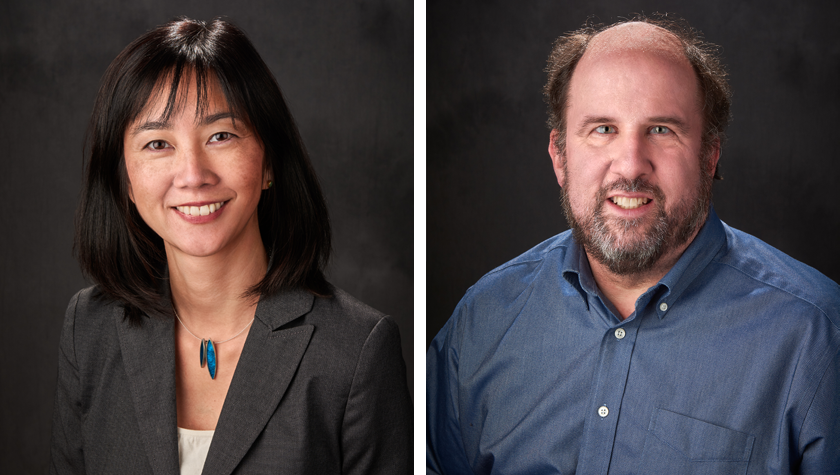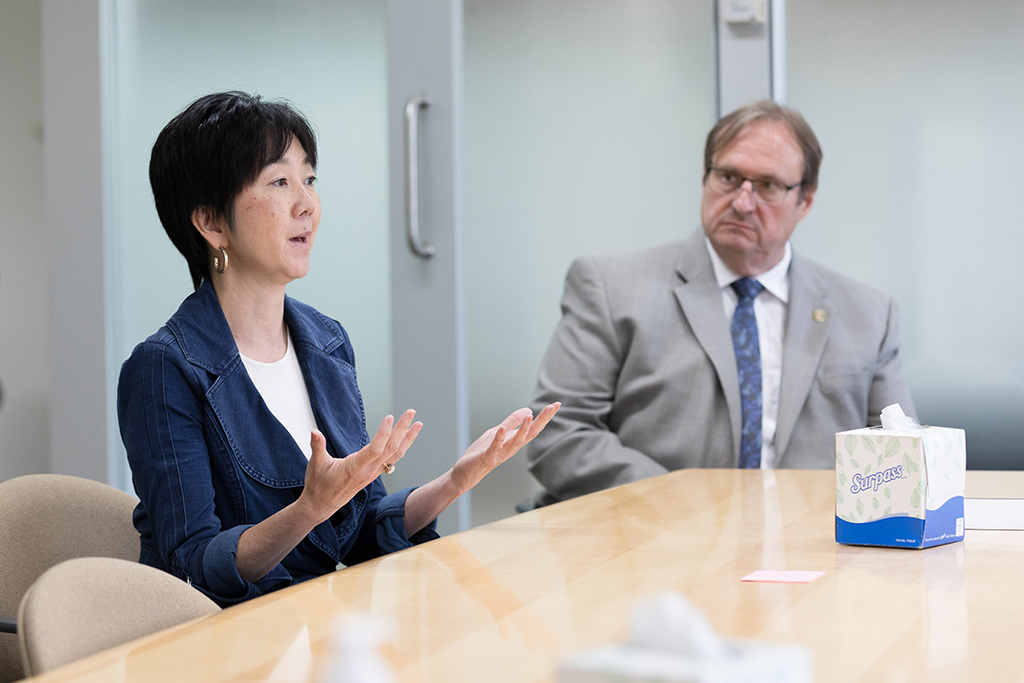
9
December

School of Pharmacy Researchers receive a grant from AHRQ to improve medication safety through resilience engineering
By Maren Stewart & Katie Gerhards
The role of a pharmacist isn’t what it used to be — in a wonderful way. Pharmacies have long been community hubs where patients could get their medications, their news, a fountain soda, and maybe even lunch. But today’s pharmacies remain a community mainstay for a broadening spectrum of health needs, from medication dispensing and patient education, to vaccinations and point-of-care testing.
“Pharmacists have taken on COVID-19 testing and vaccinations, and the expansion of vaccinations continues to increase with new RSV vaccines,” says Professor Michelle Chui, chair of the Social and Administrative Sciences Division in the University of Wisconsin–Madison School of Pharmacy. Wisconsin’s pharmacists have also recently been granted provider status, slated for implementation in early 2024, meaning pharmacists can get reimbursed for Medicaid services. That change opens the door for pharmacies to further expand their offerings.
“With all of the new opportunities pharmacists have, they still have to fill prescriptions and educate their patients, who often have complex disease states, and support them at home with medications,” says Chui. “So how do we think about adding more responsibilities while also increasing safety?”
“How do we think about adding more responsibilities while also increasing safety?”
—Michelle Chui
With a new four-year grant from the Agency for Healthcare Research and Quality, Chui and Jay Ford, associate professor in the School’s Social and Administrative Sciences Division, are mapping the path to a solution through their ENRICH (Engineering Resilient Community Pharmacies) project.
“Our goal is to try to understand how to improve and support the next generation of community pharmacies in all different communities,” says Chui.
Transforming pharmacy safety
Medical errors have been considered an American epidemic by the Institute of Medicine since 1999, says Chui.
“It’s this hidden, invisible phenomenon in which patients were dying and being harmed because of errors that were taking place in the healthcare environment,” she says.

Despite an outpouring of funding and research since then, progress toward improving patient and medication safety has stagnated, Chui says, in part due to the current framework in place to evaluate and prevent errors. That framework is the Safety-I approach, which focuses on identifying an error, determining the contributing factors to that error with a full root cause analysis, and then figuring out how to prevent that error from happening again.
“The problem is that errors take place less than 1 percent of the time — less than 1 percent of patients, certainly less than 1 percent of prescriptions,” says Chui. “That doesn’t provide a lot of data for us to go on to figure out how we can prevent that error from taking place again.”
Because of this focus on the 1 percent, the majority of data — from the interactions where all goes well — is discarded, limiting the potential for improvement.
“We’re not really doing a better job, despite the onset of more technology, because the approach that we’re taking to address safety isn’t working optimally for how we can do this,” says Chui.
Chui and Ford propose adopting a new framework — the Safety-II approach — that instead leans into what’s going right, and they’re developing a Medication Safety Map to guide pharmacists as they aim to reduce errors.
Engineering resilience
Ford and Chui have partnered with Aurora Health and UW Health and Boscobel Pharmacy’s two locations to get a mix of urban and rural patient populations, including underrepresented and farming communities.
“We have ideas of how to scale up and create sustainable interventions,” says Ford. “But we need to solicit input from our partners, because they’re the ones who are going to be able to tell us what’s going to work in rural pharmacies, independent pharmacies, or urban pharmacies associated with a larger health system.”
“The idea with resilience is creating an intervention that’s going to stick with the organization, with a ground-up approach to develop meaningful content with input from the pharmacists.”
—Jay Ford
The project has four explicit goals: identify and define community pharmacy work system design requirements for safe medication practices; design and develop MedSafeMap that facilitates safe medication practices; and implement MedSafeMap in community pharmacies and pilot test its impact on pharmacy staff attitudes, behaviors, and performance. A thread pulling all the goals together is the idea of resilience.
“Resilience is the ability for people to adapt, understand what went wrong and what went right, and focus on expanding what we already do,” says Chui. “In community pharmacies or other health care settings, the idea of resilience is the ability to think about what’s going on in that setting, leverage what you’re doing really well, and then do that better.”
Another facet of resilience is staying power, says Ford.
“The idea with resilience is creating an intervention that’s going to stick with the organization, with a ground-up approach to develop meaningful content with input from the pharmacists,” says Ford. “We’re essentially going in there with a blank piece of paper, asking them to help us create this map. And we’re going to have a lot of paper on the floor before we sketch the right path.”

Resilience is embedded in the Safety-II approach, which focuses on what is going right in a pharmacy’s operations.
“With a Safety-II approach, we dig deep into how human beings are navigating tough situations, addressing crises taking place in the moment, and anticipating the problems that could take place,” says Chui. “We want to understand those human values and actions that are taking place in community pharmacies so we can adapt those types of variations to other issues and use that to expand and improve and make safety more robust in community pharmacies.”
With the pharmacists’ perspectives, Chui and Ford will build their Med Safety Map, which will be a guide to help pharmacists navigate particular situations, based on what’s working well.
“We don’t want this project to be a researcher-dominated project — we want full and authentic participation from pharmacies that are doing this heroic work of taking care of patients in their settings,” says Chui. “They are the ones who have the expertise.”
Michelle Farrell (BS ’99, PharmD ’00), who owns Boscobel Pharmacies, leads the Wisconsin CPESN.
“As the CPESN WI lead luminary, I am so excited about this project and opportunity to collaborate on work to enhance the safety of our patients within our practices,” says Farrell. “This work is incredibly timely as our Wisconsin community pharmacies — pharmacists and pharmacy technicians — work together to evolve toward implementation of provider status.”
A trailblazing initiative
The AHRQ grant that Chui and Ford received is through the agency’s Patient Safety Learning Lab (PSLL), a funding mechanism that encourages engineers and clinicians to work together to understand the problems and contributing factors to patient safety, then use that information to move forward with improvement and interventions.
“This is not a typical grant, where we would come to the funder and say, ‘This is our solution; help us evaluate it,’” says Chui. “The purpose of this grant is to approach the health system with an open mind to understand the problems without any preconceived notions of what the issues are, using this partnership between engineers and pharmacists. I’m a pharmacist and Jay is an engineer. This is why this relationship works.”
The AHRQ agreed, scoring their grant application in the 1st percentile with a perfect score of 100. Their PSLL grant is the only one awarded by the AHRQ that focuses on outpatient medication safety, using community pharmacies as the touchpoint.
“This puts University of Wisconsin as the leading university focused on medication safety and community pharmacies.”
—Michelle Chui
“This puts University of Wisconsin as the leading university focused on medication safety and community pharmacies,” Chui says. “There’s no other school of pharmacy in the country taking a theory-based interdisciplinary approach to outpatient medication safety, like we do.”
Through the grant, the team will first develop a tool that they can then evaluate in the participating community pharmacies to get an understanding of what works and what doesn’t work, and then work toward a large clinical trial to get more community pharmacies involved.
Chui envisions Wisconsin as a testing ground for these innovative ideas — through partnerships with the Pharmacy Society of Wisconsin and CPESN (the Wisconsin Community Pharmacy Enhanced Services Network) — which could then be scaled up to reach pharmacies nationwide.
“As healthcare professionals, we need to leverage the conceptual models and methods of health systems and human factors engineers to make a broad impact on patient safety,” says Chui. “This work of collaborating with Jay to develop a laboratory to do this is really the culmination of my career and 16 years of effort at UW Health. This is a match made in heaven.”





